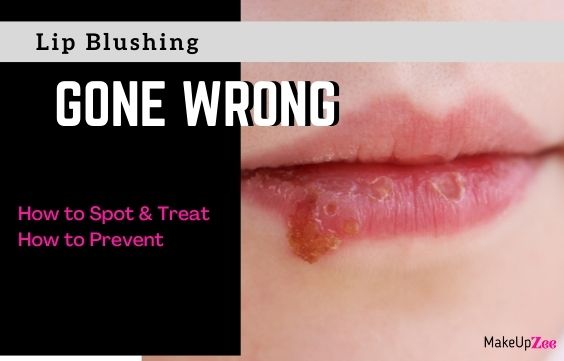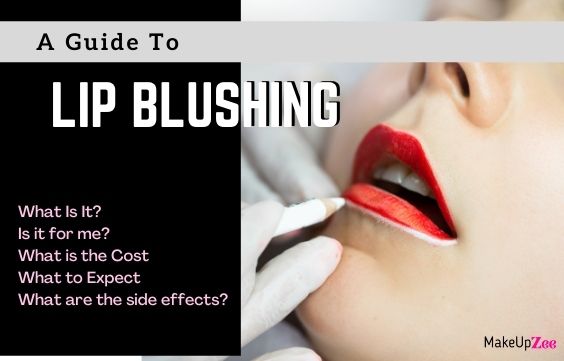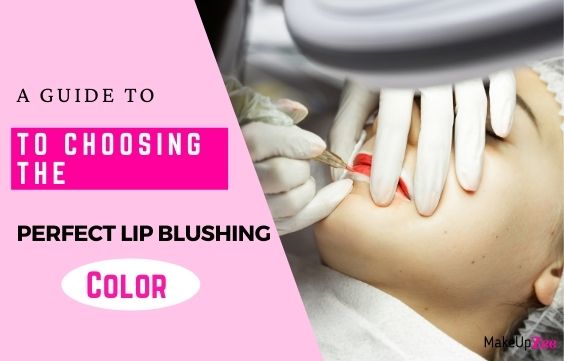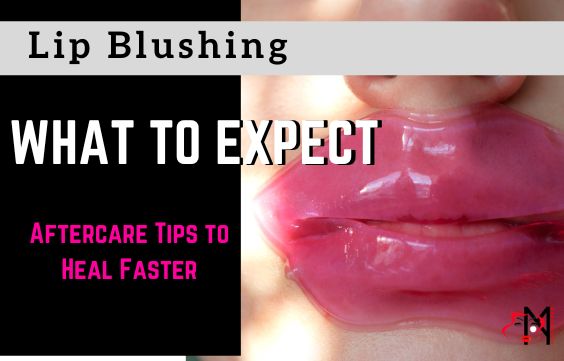Lip Blushing Gone Wrong – What to Do & How to Prevent

Lip blushing generally comes with a few mild and manageable side effects. The extent to which these occur usually varies from person to person.
These side effects are your body’s natural response to the procedure, foreign substance (ink), and part of its healing process.
Related Article: Lip Blushing What to Expect & Aftercare Tips to Heal Fast
Normal Side Effects After Lip Blushing
- Following the procedure, there will be some swelling. Some people’s lips will swell more than others. Most people will look like they have just had lip fillers injected.
- Redness is also common, albeit less so, and some bruising and crusting can happen.
- As with any inking procedure, there will be some peeling and oozing of lymph fluid (a slightly yellowish fluid) as the tattoo heals. This is normal and it is a natural part of the skin’s healing process.
However, in some cases, people may experience a reaction that is beyond normal. This can be caused by several things. Here is what they can be and what we found that could be helpful.
Possible Complications of Lip Blushing
Keep in mind that even though lip blushing is not like a traditional tattoo, it is a similar technique and carries many of the same risks as a traditional tattoo.
If lip blushing is not done properly, you may be at risk of;
- Dissatisfaction with the outcome such as uneven coloring
- Cold Sores
- Infections
- Allergic reactions, Rashes,
- Blood-borne illnesses from shared equipment,
- Bumps
- Developing complications during future MRI procedures
So in this article, we are going to walk you through how to spot if your lip blushing has developed any of these complications and how to prevent and if needed treat it.
1- Dissatisfaction With Lip Blushing
The most common complication of lip blushing is the procedure not having the expected or desired results.
This can mean that:
- The color ends up different or patchy,
- that your lip outline is not as neat or that the shape is either not correct or over-enhanced,
- that it was too painful or did not heal properly, or any number of things that can cause you to not like the outcome.
Since lip blushing will last a few years, apart from laser removal or correction, there is not much else you can do to change the appearance of your lips after the procedure.
To prevent a disappointing outcome, you should do your research on the procedure and the technician. Make sure that you know what you are getting into and ask all of your questions. And, always do a patch test!
Now one of the most important things you need to do is pick the right color for your lip blushing. I have an entire article that will guide you on how to pick the correct color for lip blushing.
2- Cold Sores/Blisters Develop
Blisters can form as a result of the needle’s stimulation during lip tattooing. It has the potential to derail the surgery and exacerbate the healing process. Furthermore, it may lead to pigment loss.
Sometimes cold sores are a sign of the Herpes Simplex Virus. If you have a history of this viral infection, you should not have lip blushing done.
Related Article: Lip Lightening Laser: What is it, Cost, Pros & Cons
How can you manage & prevent Cold Sores
Another touch-up maybe necessary for this situation to fill in fading areas. Cold sore commonly appears a few days following the procedure.
The danger may be reduced by using a delicate and mild permanent makeup machine, as well as proper aftercare, and only using the cream advised by your technician to moisturize your lips.
The treated region should not be rubbed, traumatized, touched, or picked at. Do not pick at scabs if they appear.
People who acquire cold sores should take antiviral medicine to prevent them.
Related Article: Lip Blushing 101: How long Does it Last, Costs, Pros & Cons
3- Infection After Lip Blushing
Infectious disorders such as hepatitis, and skin infections caused by Staphylococcus aureus (“staph”) and other bacteria can be transmitted via contaminated tattooing equipment and needles. Citation.
For twelve months, tattoos obtained at facilities not regulated by your state or at facilities that utilize unsterile equipment (or reused ink) may preclude you from being accepted as a blood or plasma donor.
Contaminated tattoo inks have also caused infections, even when the tattoo artist followed sanitary precautions.
How to Manage & Prevent Lip Blushing Infections
Antibiotic therapy may be required for certain infections.
Lip infections can quickly spread, worsen, or develop into facial fasciitis (a rapidly progressing infection of the soft tissue in the face) that is life-threatening.
If you notice your lips developing blisters, sores, swollen for longer than expected, and getting bigger, that your face is beginning to swell, or that you have a fever, contact a doctor and obtain medical help right away. Infections of the face cannot be treated at home.
To prevent infections:
- Make sure that the equipment being used on you is sterile and not reused, especially needles
- Make sure that the environment is clean and that your technician is following all the right sanitary precautions.
- Ensure that your skin is properly cleaned and prepared.
- Ensure that the pigment being used comes from a sealed and unused container.
- Ensure that you are keeping your lips clean and following the right aftercare instructions after your procedure to avoid developing an infection as your lips heal.
4- Allergic Reaction to Lip Blushing Ink
Although the FDA has received multiple complaints of adverse reactions to certain hues of ink in permanent and semi-permanent cosmetics, allergic responses to tattoo pigments have been uncommon.
However, because the pigments can be difficult to remove, reactions can be extremely unpleasant when they occur. People who have had tattoos for years may occasionally develop an adverse reaction to them.
Allergic reactions may present as a rash, bumps, swelling, or in the worst case, anaphylaxis (a life-threatening reaction that sends your body into shock and is a medical emergency).
You can tell that you may be going into anaphylactic shock if you have sudden trouble breathing, chest pain and tightness, wheezing, extreme dizziness and fainting, nausea, vomiting, and/or diarrhea.
What can you do to manage & prevent allergic reactions?
If your allergic reaction is just on the skin (rashes, hives, bumps, flushing, etc) and it is not worsening rapidly, you may seek medical help from your dermatologist or a doctor via appointment.
Some reactions can be treated at home over some time, but always need to be seen by a doctor so that the right medication and instructions can be prescribed.
Medications may include oral and topical antihistamines (anti-inflammatory medication).
However, if your symptoms are getting worse very fast, or if you have signs of anaphylaxis, you need to call 911 immediately or go to the nearest emergency room as quickly as possible. You will need immediate medical attention.
To prevent allergic reactions, your best bet is to do a patch test or two before going all in. You cannot always anticipate an allergic reaction, but doing a patch test will give your body time to get used to the pigment.
5- Granulomas From Lip Blushing
This is a rare reaction to the darker inks or pigments. This happens as the body recognizes the ink as foreign and mounts an immune response to try and seclude it.
What can you do to manage & prevent granulomas?
Granulomas require technical medical treatment and will need to be seen and treated by a doctor/dermatologist. They may not develop immediately and maybe a delayed reaction to the pigment.
Treatment may include topical or injectable steroids and/or laser ablation. However, treatment will vary based on the extent of the reaction.
There is no way to anticipate and prevent granulomas other than by patch testing and even that may not work.
Granulomas may take weeks or months to develop after the procedure, and we doubt anyone waits that long after a patch test to have their lip blushing done.
6- Keloid Formation
You are at risk of acquiring keloids from a tattoo especially if you are prone to developing keloids, which are scars that expand beyond their typical bounds.
This means that you usually develop scars that look bumpy or raised and thickened. Keloids can occur whenever your skin is injured or traumatized.
The good news is that unless you have a history of this kind of scarring, the chances of it developing on your lips from lip blushing are rare.
What can you do to manage and prevent keloids?
Keloids are another complication that will need to be seen and treated by a dermatologist They are not life-threatening, but if they develop on your lips, you will want to have them treated as soon as possible.
Sadly, there is no way to prevent keloid formations since it is really to chance and genetics.
7- Lip Blushing Can Cause Issues during future MRI procedures
People with tattoos or permanent/semi-permanent makeup like lip blushing have reported experiencing swelling or burning in the afflicted regions after undergoing magnetic resonance imaging (MRI).
This appears to happen infrequently and with no obvious long-term consequences.
Pigments have also been reported to interfere with the quality of MRI images. This appears to happen most often when a person with permanent eyeliner has an MRI of the eyes.
However, the dangers of delaying an MRI when your doctor recommends it are likely to outweigh the chances of problems from an MRI and tattoo or permanent makeup contact.
If you have tattoos or permanent/semi-permanent makeup, you should tell the radiologist or radiologic technician instead of avoiding an MRI.
Sources/Citations
Lip Blushing Side Effects – Healthline



